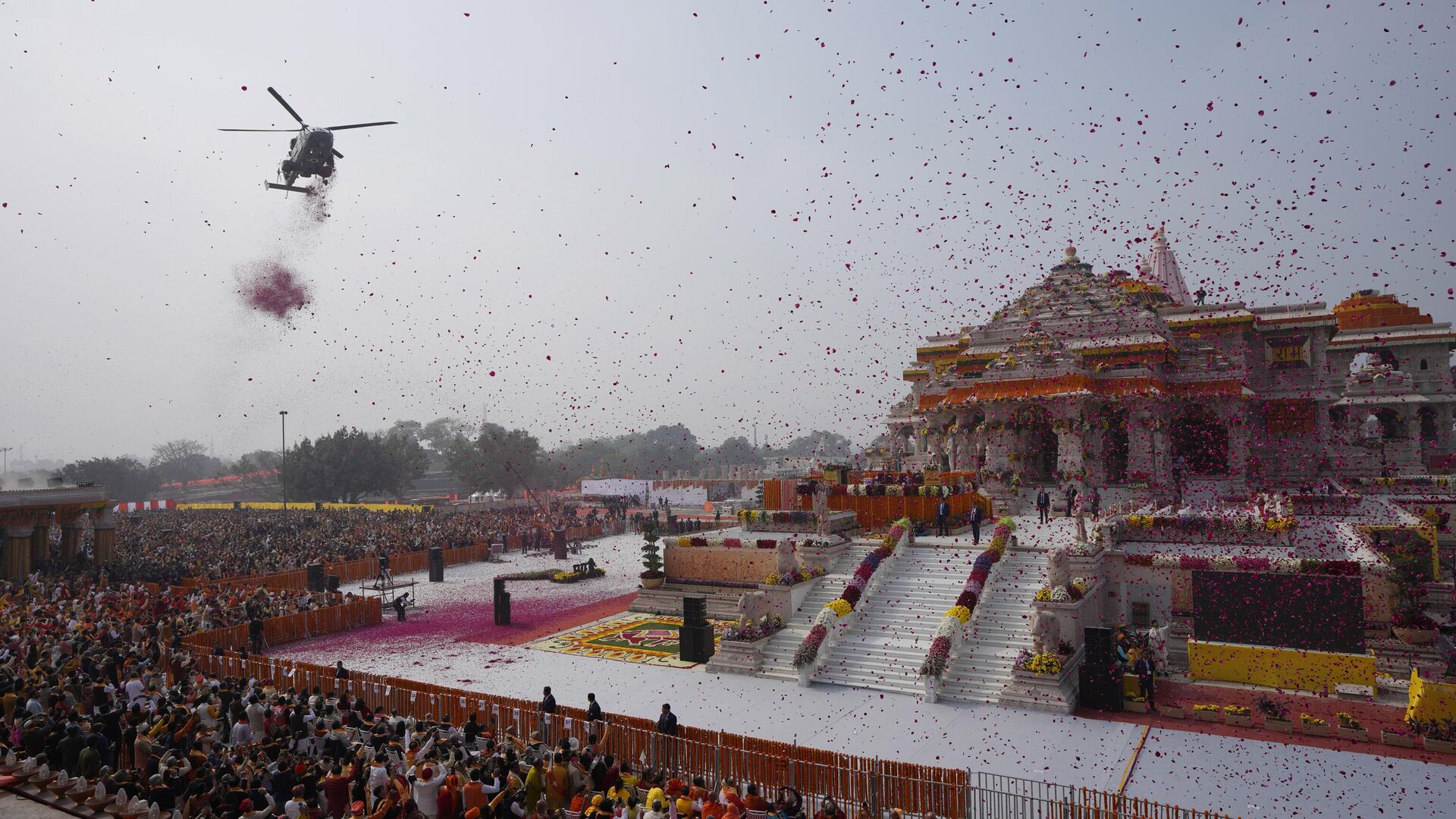Exposing Flaws & Bias Surrounding West’s Narrative on Ayodhya Ram Temple

© AP Photo / Rajesh Kumar Singh
Subscribe
A nearly five-century wait ended with the inauguration of the Ram Temple in Ayodhya on 22 January. However, this historic event has been surrounded with a barrage of anti-Hindu criticism in the West. Sputnik India worked to dig deeper in order to debunk their bias.
On Monday, Indian Prime Minister Narendra Modi headlined the consecration ceremony of the grand Lord Ram Temple in Ayodhya.
The Supreme Court paved the way for the construction of the temple following a centuries-long dispute in 2019 after the Babri Mosque that stood there in 1992 was destroyed by an enraged mob.
The Supreme Court paved the way for the construction of the temple following a centuries-long dispute in 2019 after the Babri Mosque that stood there in 1992 was destroyed by an enraged mob.
History of the Ram Temple-Babri Mosque Dispute
Though the demolition of the mosque in the 1990s led to widespread riots in India, historical evidence suggested that a mega Ram Temple previously stood at the site before Mir Baqi, a military commander in Mughal ruler Babur's armed forces, razed it to turn the place into a Muslim religious place in 1528.
Despite the destruction of one of their holiest shrines, the Hindus continued to wage a battle for the temple with the Marathas first seeking control of the site in the early 1750s.
This was followed by a demand by a group of Sikhs in 1858 that the Babri Mosque be declared the birthplace of Lord Ram. For the uninitiated, Lord Ram is revered in Sikhism, with the Hindu God finding a place in the religion's holy scriptures, the Guru Granth Sahib and the Dasam Granth.
Subsequently, in 1885, a priest named Raghubar Das, associated with Nirmohi Akhara, a religious sect within the ambit of Hinduism, that considers Lord Ram as their main deity, filed a first legal case on the issue in a British court. India was under the rule of the British crown at the time.
This was followed by a demand by a group of Sikhs in 1858 that the Babri Mosque be declared the birthplace of Lord Ram. For the uninitiated, Lord Ram is revered in Sikhism, with the Hindu God finding a place in the religion's holy scriptures, the Guru Granth Sahib and the Dasam Granth.
Subsequently, in 1885, a priest named Raghubar Das, associated with Nirmohi Akhara, a religious sect within the ambit of Hinduism, that considers Lord Ram as their main deity, filed a first legal case on the issue in a British court. India was under the rule of the British crown at the time.
ASI Surveys Confirm Grand Temple Did Exist Beneath Babri Mosque
Post-independence, the Archaeological Survey of India (ASI), carried out two excavations - one before the demolition of the Babri Mosque in 1976-77 and the other after its destruction, both of which confirmed the existence of a large-scale temple structure beneath it.
KK Muhammed, the ASI's regional director and a member of the team that carried out the first excavation at the site in 1976-77 underlined that there was "strong archeological evidence" of a mega temple structure below the Babri Mosque in Ayodhya.
"Archaeologically there is enough evidence to say that below the controversial Babri mosque, there were temple remains. In fact, there was a grand temple structure," Muhammed said in an interview in 2019.
Ayodhya Ram Temple as Important For Hindus as Mecca is for Muslims
Furthermore, he stressed that the "Ram Temple at Ayodhya is as important for Hindus as Mecca and Medina are for Muslims."
"For Muslims, it is neither associated with Prophet Mohammed nor with any of his prominent companions in Islam nor with any Auliya like Khwaja Moinuddin Chisti of Ajmer, Nizamuddin Auliya of Delhi or Salim Chisti of Fatehpur Sikri or any Islamic divine personality," Muhammed noted.
Interestingly, in the run-up to the consecration ceremony of the Ram Temple, Muslims, at least the ones who were residing in Ayodhya, welcomed its construction, because the Babri Mosque held little significance as it was in no way associated with Islam's founder, Prophet Muhammad or his family members.
Against this backdrop, Sputnik India spoke with Athar Husain Siddiqui, the secretary of the proposed Indo-Islamic Cultural Foundation (IICF), which is being built on the Supreme Court's orders after it asked the government to grant five acres of land to the Muslim side in place of the Babri Mosque site if the Ram Temple could emerge as a fulcrum of Hindu-Muslim unity in the nation.
Siddiqui emphasized that Lord Ram represents Awadh and Ayodhya is a part of the Awadh region and Awadh is known worldwide for its Ganga-Jamuni tehzeeb (Ganges–Yamuna Culture - North India's composite high culture that focuses on unity between people of different religions).
Against this backdrop, Sputnik India spoke with Athar Husain Siddiqui, the secretary of the proposed Indo-Islamic Cultural Foundation (IICF), which is being built on the Supreme Court's orders after it asked the government to grant five acres of land to the Muslim side in place of the Babri Mosque site if the Ram Temple could emerge as a fulcrum of Hindu-Muslim unity in the nation.
Siddiqui emphasized that Lord Ram represents Awadh and Ayodhya is a part of the Awadh region and Awadh is known worldwide for its Ganga-Jamuni tehzeeb (Ganges–Yamuna Culture - North India's composite high culture that focuses on unity between people of different religions).
Lord Ram Personifies Ganga-Jamuni Tehzeeb
"We call Lord Ram as Maryaada Purushottam (the World's most dignified man), and he personifies the Ganga-Jamuni tehzeeb which we call it in the present time. So this is the culture, which is very close to every Awadhi's heart, and here the Hindus and Muslims have a shared struggle, and shared legacy," Siddiqui said in a conversation with Sputnik India.
He pointed out that during the first war of independence in 1857, Muslims and Hindus fought together against the British colonialists. For instance, in Jhansi, a military commander known as Azimullah Khan fought for Queen Laxmi Bai and Hindu chieftains battled the British in favor of Awadh's Muslim ruler Begum Hazrat Mahal.
"The Ram Mandir issue has been settled through a long-drawn legal battle, and with the consecration ceremony of the temple, I believe Hindus and Muslims will give a message to the entire world that now both communities are working together to shape India into a great nation which India is," he opined.
Muslims Actively Involved in Ram Temple's Construction
On the other hand, Iqbal Ansari, an ex-litigant in the Ram Janmabhoomi (birthplace)-Babri Masjid case, who took part in the consecration ceremony on Monday, denied that there was any discord between Muslims and Hindus over the Ram Temple, asserting that it was a "media creation".
"Hindus and Muslims have been living in harmony for centuries in Ayodhya. In fact, Muslims have been actively engaged in the construction of the temple and other activities around the site, including selling of garlands, transporting pilgrims from one place to another," Ansari told Sputnik India. "Hence, there's no doubt that the Ram Temple will become a symbol of unity among Bharat's Hindus and Muslims."


